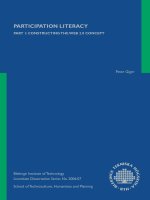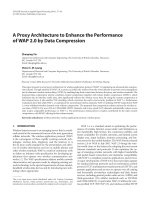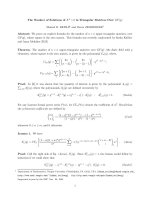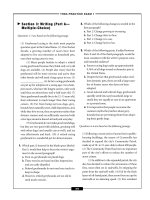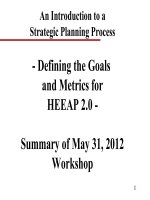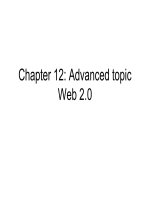The adoption of web 2 0 within enterprises employees perspectives
Bạn đang xem bản rút gọn của tài liệu. Xem và tải ngay bản đầy đủ của tài liệu tại đây (2.95 MB, 287 trang )
THE ADOPTION OF WEB 2.0 WITHIN
ENTERPRISES: EMPLOYEES’
PERSPECTIVES
Fayez Hussain Alqahtani
Bachelor of Computing, Master of IT
A thesis submitted in fulfilment of the requirements for the degree of
Doctor of Philosophy
School of Information Systems
Queensland University of Technology
Brisbane, Australia
2013
Keywords
Enterprise 2.0, Web 2.0, IT adoption, Qualitative study
Keywords
i
Abstract
The internet revolution has provided valuable opportunities for business. In the
last few years, a recent internet technology called Web 2.0 has become a common
phenomenon and has been increasingly introduced into organisations. The use of
Web 2.0 in organisational contexts is known as Enterprise 2.0. Employees’ use of
Web 2.0 within organisations enhances their communication, collaboration and
knowledge sharing. Despite the valuable benefits of Web 2.0, its adoption by
employees is challenging and lengthy. After organisations introduce Web 2.0
technologies, the next step is for employees to adopt it. However, this is not a smooth
process. It may meet with employee resistance.
Investigating employees’ adoption of Web 2.0 is important for a number of
reasons. First, enterprises’ implementation of this emerging technology needs to be
driven by individual employees as organisations cannot force employees to adopt it.
In addition, Web 2.0 is community-based technology where a group of people
interact with each other while using them: the more employees who adopt Web 2.0,
the higher the chance for these technologies to succeed. The third reason is that a
number of studies reported employees’ low adoption of Web 2.0 within
organisations. Furthermore, the adoption of Web 2.0 and what influences its adoption
are still nebulous and commentators advocate exploring this issue. Therefore, this
research explores the adoption of Web 2.0 including what influence employees’
adoption and how employees are influenced by these issues to adopt Web 2.0.
This research started by analysing the relevant literature in order to develop an a
priori Enterprise2.0 adoption model. Reviewing related studies helped to synthesise
potential adoption issues that could influence employees to adopt Web 2.0, hence the
Abstract
ii
review assisted in developing the a priori model. Then a qualitative study in two
phases was used. In the first phase, two focus groups of employees were used to refine
and extend the synthesis of adoption influences from the literature. The focus group also
helped in developing the interview protocol. In the second phase, eighteen employees
were individually interviewed to enrich the understanding about how the adoption
influences as presented in the a priori model influence the adoption as well as exploring
new adoption issues.
This study developed an Enterprise 2.0 adoption model. It shows that the
adoption of Web 2.0 by employees is a challenging and dynamic process that
changes over time. Employees’ adoption of such technologies is influenced by a
number of interrelated issues. These adoption issues are represented in eight themes:
People Traits, Social Influence, Trust, Technological Attributes, Relevance of Web
2.0, Web 2.0 Maturity, Organisational Support, and Organisational Practice. These
adoption issues interrelate with each other during the adoption process and exert their
influence on employees’ adoption. These issues can be motivators, hindrances or
both. Also, these issues can influence employees’ level of engagement with Web 2.0
and the frequency of their using Web 2.0.
Abstract
iii
Table of Contents
Keywords ..................................................................................................................... i
Abstract ....................................................................................................................... ii
Table of Contents ...................................................................................................... iv
Statement of Original Authorship ......................................................................... viii
Acknowledgments ..................................................................................................... ix
Scholarly Activities..................................................................................................... x
Chapter 1 Introduction .............................................................................................. 1
1.1
Research Problem......................................................................................... 1
1.2
Research Scope ............................................................................................ 2
1.3
Research Questions ...................................................................................... 4
1.4
Significance of the Research ........................................................................ 7
1.5
The Research Study...................................................................................... 9
1.6
Summary of Findings ................................................................................... 9
1.7
Key Concepts ............................................................................................. 10
1.8
Thesis Structure.......................................................................................... 12
1.9
Conclusion ................................................................................................. 13
Chapter 2 Literature Review .................................................................................. 15
2.1
Enterprise 2.0 ............................................................................................ 16
2.1.1 Definition of Web 2.0 ............................................................................ 16
2.1.2 Web 2.0 characteristics .......................................................................... 17
2.1.3 Web 2.0 applications .............................................................................. 19
2.1.4 Definition of Enterprise 2.0.................................................................... 20
2.1.5 Enterprise 2.0 technological features ..................................................... 21
2.1.6 Enterprise 2.0 benefits ............................................................................ 23
2.1.7 Enterprise 2.0 risks ................................................................................. 26
2.1.8 Enterprise 2.0 emerging models............................................................. 27
2.1.9 The role of Web 2.0 within organisations ................................................. 28
2.1.10 Implementation challenges..................................................................... 29
2.2
Adoption of Information Technology ....................................................... 30
2.2.1 IT adoption definition ............................................................................ 31
2.2.2 Major perspectives of IT adoption ......................................................... 32
2.2.3 The study’s theoretical perspective ........................................................ 40
2.3
The Adoption of Web 2.0 within organisations ........................................ 41
2.3.1 The importance of studying the adoption............................................... 41
2.3.2 Related studies of the adoption of Web 2.0 ........................................... 43
2.3.3 Evaluating Enterprise 2.0 adoption studies ............................................ 46
2.4
The a priori Enterprise 2.0 User Adoption Model ..................................... 51
2.4.1 Technology............................................................................................. 51
2.4.2 Trust ....................................................................................................... 52
2.4.3 Knowledge sharing................................................................................. 52
2.4.4 Social influence ...................................................................................... 53
2.4.5 Individual ability .................................................................................... 54
2.4.6 Resource availability .............................................................................. 54
2.5
Conclusion ................................................................................................. 55
Chapter 3 Research Method ................................................................................... 57
3.1
Qualitative Research Approach.................................................................. 58
Table of Contents
iv
3.2
The Survey Method .................................................................................... 60
3.3
Data Collection........................................................................................... 61
3.3.1 Literature review .................................................................................... 61
3.3.2 Focus groups .......................................................................................... 62
3.3.3 Interviews ............................................................................................... 63
3.3.4 Participants ............................................................................................. 65
3.4
Data Analysis ............................................................................................. 66
3.5
Implementing the Data Collection and Analysis ....................................... 68
3.5.1 Literature review .................................................................................... 68
3.5.2 Focus group ............................................................................................ 68
3.5.3 Interviews ............................................................................................... 76
3.6
Research Quality ........................................................................................ 86
3.7
Conclusion ................................................................................................. 89
Chapter 4 Findings................................................................................................... 91
4.1
General Description of Enterprise 2.0 Adoption........................................ 91
4.1.1 Web 2.0 adoption is challenging ............................................................ 92
4.1.2 Typologies of Web 2.0 usage: Business and social ............................... 92
4.1.3 Ways of engaging with Web 2.0 vary significantly ............................... 93
4.1.4 Employees’ adoption of Web 2.0 occurs as a process ........................... 94
4.2
Themes of Influence on Enterprise 2.0 Adoption ...................................... 95
4.2.1 People’s traits ......................................................................................... 97
4.2.2 Social influence .................................................................................... 104
4.2.3 Trust ..................................................................................................... 106
4.2.4 Technological attributes ....................................................................... 108
4.2.5 Relevance of Web 2.0 .......................................................................... 112
4.2.6 Maturity ................................................................................................ 116
4.2.7 Organisational support ......................................................................... 118
4.2.8 Organisational practice......................................................................... 123
4.3
Conclusion ............................................................................................... 128
Chapter 5 The Model of Employees’ Adoption of Web 2.0................................ 129
5.1
Enterprise 2.0 Adoption themes ............................................................... 130
5.2
Interrelations Among Enterprise 2.0 Adoption Themes .......................... 145
5.3
Abstract of Employees’ Adoption of Enterprise 2.0 ................................ 149
5.4
Conclusion ............................................................................................... 156
Chapter 6 Discussion ............................................................................................. 157
6.1
Introduction .............................................................................................. 157
6.2
Discussing the Findings of the Study ....................................................... 157
6.3
The Significance of the new model .......................................................... 176
6.4
Conclusion ............................................................................................... 186
Chapter 7 Conclusion ............................................................................................ 188
7.1
Summary of the Key Findings ................................................................. 188
7.2
Contribution of the Study to Research ..................................................... 193
7.3
Implications of the Study to Practice ....................................................... 196
7.4
Limitations and Further Research ............................................................ 202
7.5
Conclusion ............................................................................................... 203
References ............................................................................................................... 204
Appendices .............................................................................................................. 225
Table of Contents
v
List of Figures
Figure 2.1 Web 2.0 Vs the traditional Web (Hamid, 2007) ...................................... 18
Figure 2.2 A new, updated mnemonic for Enterprise 2.0 (Hinchcliffe, 2007) .......... 23
Figure 2.3 TAM model (Davis, 1989) ....................................................................... 36
Figure 2.2.4 Extended TAM model (Venkatesh and Davis, 2000) ........................... 36
Figure 2.2.5 Unified theory of acceptance and use of technology ............................ 38
Figure 2.6 The a priori Enterprise 2.0 user adoption model ...................................... 55
Figure 3.1 The research design .................................................................................. 57
Figure 3.2 Participants’ evaluation of the six key adoption issues ............................ 75
Figure 3.3 Activities of the interview phase enquiry................................................. 82
Figure 3.4 Nvivo free nodes (initial nodes) and description ..................................... 83
Figure 3.5 Tools facilitate “searching for them” task ................................................ 84
Figure 3.6 Participants’ validation of the interviews transcripts ............................... 87
Figure 3.7 Participants’ invitation to disuses the study findings ............................... 88
Figure 3.8 An example of arranging the follow up meetings .................................... 88
Figure 4.1 Overview of Enterprise 2.0 adoption ....................................................... 92
Figure 5.1 The Theoretical Model Resulted From This Thesis ............................... 129
Figure 5.2 Interrelations among Enterprise 2.0 adoption themes ............................ 146
Figure 5.3 The Model of Employees’ adoption of Enterprise 2.0 ........................... 156
Figure 6.1 Enterprise 2.0 adoption themes .............................................................. 160
Figure 7.1 Model of Employees’ adoption of Enterprise 2.0 .................................. 193
List of Tables
Table 2.1 Potential Applications of Web 2.0 Tools in Enterprises ............................ 20
Table 2.2 Adoption of IT Innovation Perspectives Adapted from Kautz & Nielsen,
(2004) ......................................................................................................................... 33
Table 2.3 Related Studies of Enterprise 2.0 Adoption ............................................... 43
Table 3.1 Qualitative Vs Quantitative Research (Biemans, 2003) ............................ 58
Table 3.2 Research Questions and Approach ............................................................ 61
Table 3.3 Phases of Thematic Analysis (Braun & Clarke, 2006) .............................. 67
Table 3.4 Focus group participants ............................................................................ 69
Table 3.5 Focus Group Statements Supporting the six key Adoption Issues ............ 72
Table 3.6 Interviewees’ Profiles ................................................................................ 79
Table 3.7 Enterprise 2.0 Adoption Themes ............................................................... 85
Table 4.1 Enterprise 2.0 Adoption Themes and Sub-themes ..................................... 96
Table 5.1 Summary of Enterprise 2.0 Adoption Themes and Sub-themes .............. 130
Table 5.2 The Influence of People Traits on Enterprise 2.0 Adoption .................... 131
Table 5.3 The influence of Social influence on Enterprise 2.0 Adoption ................ 134
Table 5.4 The Influence of Trust on Enterprise 2.0 Adoption ................................. 136
Table 5.5 The Influence of Technological Attributes on Enterprise 2.0 Adoption . 137
Table 5.6 The Influence of Web 2.0 Relevance on Enterprise 2.0 Adoption .......... 139
Table 5.7 The Influence of Web 2.0 Maturity on Enterprise 2.0 Adoption ............. 141
Table 5.8 The Influence of Organisational Support on Enterprise 2.0 Adoption .... 142
Table 5.9 The Influence of Organisational Practice on Enterprise 2.0 Adoption .... 144
Table 5.10 Summary of “Individual” Adoption Influences ..................................... 150
Table 5.11 Summary of “Innovation” Adoption Influences .................................... 151
Table of Contents
vi
Table 5.12 Summary of “Context” Adoption Influences ......................................... 153
Table 7.1 Enterprise 2.0 Adoption Themes and Sub-themes ................................... 190
Table of Contents
vii
Statement of Original Authorship
The work contained in this thesis has not been previously submitted to meet
requirements for an award at this or any other higher education institution. To the
best of my knowledge and belief, the thesis contains no material previously
published or written by another person except where due reference is made.
Signature:
QUT Verified Signature
_________________________
Date:
_________________________
25 September 2013
Statement of Original Authorship
viii
Acknowledgments
After sincerely thanking Allah for all blessing and giving me the ability to
accomplish this thesis, I would like to thank many people for their, assistance, support
and guidance.
First of all, I would like to thank my father Hussain and my mother Rahmah for
their daily prayers, sacrifices and support to achieve my goals. Father and mother, this
achievement is a gift for you. Grateful thanks go to my wife Norah Alqahtani who
accompanied me along the joyful journey of knowledge, and who marvellously created
the right atmosphere for me to bring this research to fruition. Also, I would like to
express my deep gratitude to my sister Fatimah for listening to my worries, and to my
daughters (Shaden and Asan) for being patient during this period.
Special thanks to my supervisors for their continued encouragement, support and
valuable advice: my principal supervisor Dr. Jason Watson, and my Associate
Supervisor Professor Helen partridge. They showed me the way and guide me to become
an accomplished researchers; they spent a lot of time reading and commenting on my
thesis and guided me throughout this study‘s progress. Their support and humour will
long be remembered.
Grateful thanks are specialled to my brothers, sisters and friends who inspire and
encourage me with great kindness to pursue this degree. Also, many thanks go to staff
members and my PhD colleagues at the QUT School of Informational Systems for
giving me a memorable and enjoyable experience.
Acknowledgments
ix
Scholarly Activities
Publications:
Alqahtani, Fayez Hussain, Watson, Jason, & Partridge, Helen L. (2010) Users’
adoption of web 2.0 for knowledge management: position paper. In Brown,
Irwin (Ed.) Proceedings of the International Conference on Information
Management and Evaluation, Academic Publishing Limited, University of Cape
Town, Cape Town, pp. 19-29.
Alqahtani, Fayez Hussain, Zakaria, Mohd Hafiz, & Watson , Jason (2010) Web 2.0
applications in enterprises and education. In 2010 Proceedings of the International
Conference on e-Commerce, e-Administration, e-Society, e-Education, and eTechnology, The Grand Lisboa, Macau, China.
Alqahtani, Fayez Hussain, Watson, Jason, & Partridge, Helen L. (2011) The Use of
Social Technology to Support Organisational Knowledge. In Handbook of Research
on Business Social Networking: Organizational, Managerial, and Technological
Dimensions. Business Science Reference, Hershey, PA, pp. 140-1164.
Alqahtani, Fayez Hussain, Watson, Jason, & Partridge, Helen L. (2013). Employees
adoption of enterprise web 2.0: The role of technological attribute. In Proceedings of
the Pacific-Asia Conference on Information System 2013 (PACIS 2013), Jeju Island,
Korea.
Presentations:
Smart Tools and Services, QUT - Doctorial Consortium 2009
Information Study Group, QUT - Doctoral Consortium 2010
Information Systems School, QUT - Doctorial Consortium 2011
Information Systems School, QUT - Doctorial Consortium 2012
2013 SEF Social Media Research Symposium, Queensland university of
Technology
Articles in preparation:
Why employees may or may not use Enterprise Web2.0; for submission to the
journal Information Systems Research
Scholarly Activities
x
Chapter 1 Introduction
The internet revolution has provided valuable opportunities for business. In the
last few years, a recent internet technology called Web 2.0 has become a common
phenomenon and has been increasingly introduced into organisations to enhance
employees’ communication, collaboration and knowledge sharing. Despite the
valuable benefits of Web 2.0, its adoption by employees is challenging and lengthy.
The adoption of Web 2.0 and what influences its adoption is still nebulous and
commentators advocate exploring this issue. The current research explores employees’
adoption of Web 2.0, aiming to fill in this gap. This chapter outlines the research
problem, defines the research scope, identifies the research questions and explains
the significance of the research. It then describes the research study, explains its
contribution to research, and outlines key concepts. Lastly, this chapter introduces
the structure of the thesis.
1.1
Research Problem
Enterprise 2.0 refers to the use of Web 2.0 in organisational contexts (McAfee,
2006). Using Web 2.0 within organisations is important to enhancing work
productivity (Bughin, 2008; Onyechi & Abeyssinghe, 2009). Web 2.0 facilitates the
sharing of employee knowledge, experience and ideas in a collaborative and
interactive manner (McAfee, 2006; Wigand, 2007). Consequently, organisations
achieve several advantages which include boosting returns, reducing costs and
increasing the rate of innovation (Ali-Hassan & Nevoy, 2009; Bughin & Manyika,
2007), as well as informational and social advantages (Ali-Hassan & Nevoy, 2009).
Introduction
1
Yet, implementing Web 2.0 within organisations comes with challenges (Ali &
Deans, 2009). The largest challenge is employees’ adoption of Web 2.0 (McAfee,
2009). After organisations introduce Web 2.0 technology, the next step is for
employees to adopt it. However, this is not a smooth process; it may meet with
employee resistance and the time of adoption may be lengthy. According to INgage
Networks (2010) and MacManus (2007), Web 2.0 within organisations has not been
adopted widely by employees. Therefore, commentators believe that employees’ low
adoption is an enormous obstacle in Web 2.0 initiatives (Corso, Martini, & Pesoli,
2008; Onyechi &Abeyssinghe, 2009).
As the level of user adoption of IT systems plays an important role in the
success of these systems, studying the issues that affect their adoption has been an
important issue (Davis, 1989). Similarly, examining the adoption of Web 2.0 is an
important matter. Web 2.0 within organisations is a community based technology,
and the more employees adopt it, the higher the chance for Web 2.0 to succeed
(Bradley, 2007; Wilensky & Redmiles, 2008). The concept of Web 2.0 within
organisations is based on the engagement and collaboration between employees
(Schneckenberg, 2009). Therefore, employee adoption of Web 2.0 and their
involvement can be an issue that threatens the successful implementation of
Enterprise 2.0 According to Dwivedi, Williams, Ramdani, Niranjan and Vishanth
(2011), investigating the adoption of Web 2.0 is urgent, in order to clarify what
influences its adoption.
1.2
Research Scope
In business, Web 2.0 technologies are used in several ways, such as interfacing
with customers, partners, or suppliers or being used by employees within an
organisation (Bughin & Manyika, 2007; Corso et al., 2008). Therefore, Web 2.0 can
Introduction
2
have internal use within an enterprise and external use. For example, marketing
researchers (e.g., Constantinides, 2008; Mazurek, 2009; Rosen & Phillips, 2011)
have looked at the external use of Web 2.0, investigating how its use affects
marketing activities, such as building brand awareness and providing sales services
(Constantinides, 2009). However, the use of Web 2.0 for engaging and connecting
with external parties is out of the scope of this study.
The focus of this research is the use of Web 2.0 within an enterprise.
According to McKinsey’s survey (as reported by Manyika, 2007), 75% of
organisations implement Web 2.0 for communication among their employees,
making this the most common Enterprise 2.0 model “aiming to create new
collaboration, knowledge-sharing and relation management” (Corso et al., 2008, p.
607). In addition, the use of Web 2.0 within an enterprise provides valuable
opportunities for enterprises, as it makes them more agile, efficient, and productive
(Dawson 2009; Onyechi & Abeyssinghe, 2009). Organisations using Web 2.0
internally appear to be more efficient due to their increased collaboration, sharing of
knowledge, and fostering of innovation (Newman & Thomas, 2009). However, the
internal implementation of Web 2.0 does have its challenges (Ali & Deans, 2009;
McAfee, 2009; Onyechi & Abeyssinghe, 2009), demonstrating the need to explore
these challenges. Furthermore, the successful implementation of Web 2.0 within
enterprises is a preliminary step to extending Web 2.0 use externally. Once the Web
2.0 culture is observed internally and becomes the employees’ norm of
communication and collaboration, extending Web 2.0 to engage with external parties
is easier.
More specifically, this study focuses on employees’ experience of using Web
2.0 within an organisation rather than a top management decision to adopt Web 2.0.
Introduction
3
Mckinsey’s second survey showed that companies are continuing to increase their
investments in Web 2.0 (Bughin, Manyika & Miller, 2008). The results of this survey
were based on the responses of 1,988 executives from a range of regions and
industries.
However, this survey showed that only 21% of the respondents were satisfied
with the implementation of Web 2.0. According to INgage Networks (2010) and
MacManus (2007), Web 2.0 use within organisations has not been adopted widely by
employees, which is an enormous obstacle to Web 2.0 initiatives (Corso, Martini, &
Pesoli, 2008; Onyechi & Abeyssinghe, 2009). In other words, examining employees’
adoption of Web 2.0 is more critical than looking at management’s decision to adopt
Web 2.0 for three reasons: (1) Many organisations have already started investing in
internal Web 2.0 implementation; (2) there are free versions of Web 2.0 applications
available on the Internet and can be introduced to organisations by employees who
are Web 2.0 enthusiasts; and (3) researchers such as McAfee (2009) have
demonstrated that employees are the “biggest barriers to faster and deeper adoption
of Enterprise 2.0” (p. 164).
Therefore, the scope of this research is to investigate the adoption of Web 2.0
by employees within enterprises. In this thesis, the terms “Enterprise 2.0”,
“Enterprise 2.0 technologies” and “Web 2.0” are used interchangeably to refer to
employees’ use of Web 2.0 within enterprises.
1.3
Research Questions
The objective of this study is to understand how employees’ adoption of Web
2.0 is influenced. This involves exploring the adoption issues and then examining
how these issues influence employees to adopt Web 2.0 within organisations. A
Introduction
4
better understanding of these issues helps in managing them in a way that makes
Enterprise 2.0 initiatives succeed.
The investigation research questions which address the objective of this study are:
1. What are the adoption issues that influence Web 2.0 adoption within
organisations?
2. How do these adoption issues influence employees’ adoption of Web
2.0 within organisations?
The answer to these two research questions provides useful contributions to the
body of knowledge regarding employees’ adoption of Web 2.0 within organisations.
Previous studies recognised the low adoption of Web 2.0 as an enormous obstacle in
Web 2.0 initiatives within enterprises (Corso, Martini, & Pesoli, 2008; Dwivedi et
al., 2011; Onyechi &Abeyssinghe, 2009; McAfee, 2009). Yet, there is a lack of
research investigating the causes of such low adoption rates among employees
(Dwivedi et al., 2011).
Over the past few years, studying the adoption of Web 2.0 within organisations
has received attention from researchers (e.g. Bradley, 2007; DiMicco et al., 2008;
Hester, 2011; Hester & Scott, 2008; Paroutis & Al Saleh, 2009). Yet, only a few
studies (e.g. DiMicco et al, 2008; Hester, 2011) have examined Web 2.0 adoption
empirically to identify the adoption issues that could influence employees’ adoption.
Addressing the first research question contributes to the literature by extending the
adoption influences identified by other studies. Also, this extension encompasses a
larger view to explore adoption influences that are related to individual employees,
the innovation itself (Web 2.0) or the context (enterprises).
Introduction
5
Furthermore, this thesis focuses on illustrating how adoption issues influence
employees during the adoption process. Unlike other IT systems, Web 2.0 is a social,
participatory and voluntary technology (Riedl & Betz, 2012), which increase the
complexity of its adoption. Addressing the second research question using the
Interactive process perspective as a theatrical lens helped to obtain a comprehensive
view of the adoption process and to deal with the complexity of Web 2.0 adoption.
There are three perspectives of IT adoption: individualist, structuralist and interactive
processes (Slappendel, 1996). The source of the causes of adoption and how adoption
occurs differentiates these perspectives from each other. The individual perspective,
apparent in the Technology Acceptance Model (TAM) and other similar models, views
the adoption of innovation as a simple and static process caused by the actions of
individuals and their personal characteristics (Kautz & Nielsen, 2004).
The interactive process perspective assumes that the adoption of an innovation like
Web 2.0 is dynamic and continuously changing because of the interrelation between
individuals and organisational influences, as well as the innovation itself. The focus of
studying IT adoption is based on the “individualist” perspective by using TAM-like
models. Yet, assuming that the adoption of an innovation is static and an objective
phenomenon that can be determined by personal factors is a limited view (Slappendel,
1996). Therefore, this thesis contributes to the literature by exploring and illustrating
how employees are influenced to adopt Web 2.0 based on the interactive process
perspective.
Introduction
6
1.4
Significance of the Research
Some commentators such as Ali-Hassan and Nevoy (2009), Alqahtani, Watson
and Partridge (2010), Onyechi and Abeyssinghe (2009) and (McAfee, 2009a) value
Web 2.0 benefits for organisations which include enhancing work productivity,
boosting return, reducing cost and increasing the rate of innovation. Yet, most of
these commentators indicate that employees’ adoption of Web 2.0 is recognised as
the largest challenge that prevents enterprises from obtaining Web 2.0 benefits.
In the context of Information Systems (IS), adoption refers to users’ use of
these systems. Studying the issues that affect the adoption of IT technology has been
an important issue (Davis, 1989). Studying individuals’ adoption of IT systems such
as Enterprise Resource Planning (ERP), e-government or e-banking have received a
lot of attention. However there is a lack of examination of Web 2.0 adoption
(Dwivedi, Williams, Ramdani, Niranjan, & Vishanth, 2011; Kosalge & Tole, 2010).
According to Dwivedi and colleagues (2011), commentators are still unclear
about what influences the adoption of such social technology. In addition,
enterprises’ implementation of this emerging technology needs to be driven by
individual employees as organisations cannot force employees to adopt it (Kosalge &
Tole, 2010). Therefore, understanding employees’ adoption of Web 2.0 is important
as such technology is based on employees’ engagement and collaboration. The
“Interactive process” is one perspective used to examine the adoption of
innovations/technologies (Kautz & Nielsen, 2004; Slappendel, 1996). From this
perspective, the assumption about the adoption of innovation is that it is dynamic and
continuously changing because of the influence of issues related to individuals and
organisations as well as the innovation itself (Kautz & Nielsen, 2004).
Introduction
7
Although the adoption of Web 2.0 within organisations receives researchers’
attention from industry (e.g. Bradley, 2007; DiMicco et al., 2008) as well as from
academia (e.g. Hester & Scott, 2008; Paroutis & Al Saleh, 2009), there is a need to
further investigate this phenomenon for three reasons. First, some of these studies
intended to explore the benefit of using Web 2.0 rather than how that could influence
its adoption. Additionally, other studies conceptually studied the adoption but lacked
empirical support. Lastly, a few studies examined Web 2.0 adoption empirically and
identified a number of adoption issues. However, due to the complexity of Web 2.0
adoption, it needs to be examined thought the “Interactive process” perspective to
obtain a comprehensive view of the adoption process.
The two major entities that could benefit from this research are academia and
industry. This research project is related to two academic areas within the
information system discipline, namely information technology (IT) acceptance and
Enterprise 2.0. During the last 20 years, IT adoption research has been conducted to
explain why information systems users accept or reject these systems. Several
general IT adoption theories and models have been developed, and many research
projects have been conducted in the area to extend these models to explain a
particular IT technology and/or in a particular context. This research will explore
Enterprise 2.0 adoption issues and how they influence the adoption process.
At the end of the study, industry will gain advantages from this research. It will
provide recommendations on how to drive the adoption of Web 2.0 and manage
employee issues in order to make Enterprise 2.0 initiatives a success. Consequently,
the organisations’ investments in Web 2.0 will not be wasted and the opportunities
offered by such technology can be achieved.
Introduction
8
1.5
The Research Study
Understanding employees’ adoption of Web 2.0 within organisations is the
objective of this study. In order to gain this understanding, the researcher explored
the adoption issues and how they influence the adoption process. The exploratory
nature of this study has suggested a qualitative approach to examine such a complex
sociotechnical phenomenon. In order to examine this phenomenon, this study started
by analysing the relevant literature in order to develop an a priori Enterprise 2.0 user
adoption model. Then a qualitative study in two phases was used. In the first phase,
two focus groups of employees were used to refine and extend the synthesis of
adoption influences from the literature. Thirteen people participated in two focus
groups, seven people in the first focus group and six people in the second one. The
focus group helped in developing the interview protocol. In the second phase,
eighteen employees were individually interviewed to enrich the understanding about
how the adoption influences as presented in the a priori model influence the adoption
as well as exploring new adoption issues. This overview of the research approach
used in this study is addressed in more detail in Chapter Three.
1.6
Summary of Findings
In the current study, the research contributes to enhancing the understanding of
the adoption of Web 2.0 in three ways. Firstly, it describes the adoption of Web 2.0
within organisations. Four characteristic that describe Web 2.0 adoption were
identified: the challenge of adopting Web 2.0, business and social adoption, ways of
engaging with Web 2.0, and the occurrence of Web 2.0 adoption as a process.
Secondly, this study identified the adoption issues of Web 2.0 in eight themes:
People Traits, Social Influence, Trust, Technological Attributes, Relevance of Web
2.0, Web 2.0 Maturity, Organisational Support, and Organisational Practice. A
Introduction
9
detailed understanding of these adoption issues was developed. Furthermore, the
“interactive process” perspective of IT adoption was supported in this study by
mapping the adoption influences into its three broader categories: Individual,
Innovation and Context.
Thirdly, this study explores how employees’ adoption and engagement levels
with Web 2.0 are influenced by a range of interrelated issues. Informed by the
“interactive process” perspective views on IT adoption, this study develops a model
of employees’ adoption of Web 2.0 within organisations. This model indicates that
Web 2.0 adoption is a process that develops and changes over time because of the
influence of interrelated issues that might also be dynamic in nature. So this study
examines the eight adoption themes and how they relate to one another during the
adoption process.
1.7
Key Concepts
This study has number of key concepts which are defined in this section. These
operational definitions have been applied throughout the thesis and include:
Information systems are the use of information technology (IT) to support business
activities. Usually this term refers to the combination of IT and people activities.
Information technology is the technological aspect of information systems
including hardware such as computer and networks as well as software such as
operating systems and Web applications. In this thesis the term “information
technology” is used interchangeably with “information systems”, referring in many
cases to computer software (e.g. Web 2.0).
Innovation means introducing something new; it could refer to the new thing being
introduced. In this thesis Innovation refers to the new IT technology (Web 2.0)
introduced into an organisation.
Introduction
10
IS/IT adoption refers to users accepting new IT technologies as well as using those
technologies. In this thesis, the users are employees who are introduced to use Web
2.0 technologies within the workplace.
The “interactive process” is one of the perspectives of adopting IT innovations
within organisations. The interactive process views the adoption as dynamic and
changing over time due to the continuous interaction between individuals and
organisational influences, as well as the innovation itself.
Web 2.0 is a new generation of web-based applications that allow people to
collaborate and share information online. Examples of Web 2.0 technologies include
wikis, blogs and micro-blogs. While Web 2.0 technologies can be used on the
internet as well as within organisations, in this thesis Web 2.0 refers to its use within
organisations.
Enterprise 2.0 refers to the use of Web 2.0 by organisations to interface with
customers, to interface with partners or suppliers, and for internal use between
employees. In this thesis the use of the term “Enterprise 2.0” refers to using Web 2.0
among
employees
within
organisations.
“Enterprise
2.0”
“Enterprise
2.0
technologies” and “Web 2.0” are used interchangeably in this thesis but the intention
is to refer to employees’ use of Web 2.0 within organisations.
Organisations are social entities that are structured and managed to meet a need or
to pursue collective goals. In this thesis “organisations” refer to business types of
organisations (i.e. the private sector). These organisations can be small or large and
can be in any industry. Sometimes the word “Enterprises” is used interchangeably
with the word “organisations”.
Employees are people who are hired to provide services to a company on a regular
basis in exchange for compensation and who do not provide these services as part of
an independent business. In this thesis, employees can be from different operational
levels as well as from managerial levels and from any profession.
Introduction
11
The “a priori model” presents a preliminary understanding of employees’ adoption
of Web 2.0. It was developed in this research based on an analysis of the literature
relevant to Web 2.0 adoption. It identified six main adoption issues: technological
issues, social influences, knowledge sharing, trust, individual ability and resource
availability. This preliminary model informed the first empirical phase of this study,
which were the focus groups. The adoption issues in the a priori model guided the
focus groups’ investigations and assisted in developing their protocol.
The “Model of Employees’ Adoption of Enterprise 2.0” is the theoretical outcome
of this thesis. It was derived from the empirical phase of this study as well as from
the a priori model. This model categorises the eight adoption themes found in this
study into three broader categories, namely: individual, innovation and context. It
also shows how adoption influences within every category interact with each other as
well as with influences from other categories, resulting in employees’ engaging with
Web 2.0 to different degrees. The Model of Employees’ Adoption of Enterprise 2.0
identifies the adoption as a process that keeps changing over time, due to the
interactions among the individual, innovation and context influences.
1.8
Thesis Structure
This chapter introduced this research study by outlining the research problem,
defining the research scope, identifying the research questions as well as explaining
the significance of this research. This first chapter also outlined the research study,
its contribution to research, and explained key concepts used in the thesis. The rest of
this thesis is organised as follows.
Chapter Two reviews the literature and includes Enterprise 2.0 and IS adoption
as well as studies related to Web 2.0 adoption. This chapter provides a preliminary
understanding of the adoption of Web 2.0 and develop the a priori adoption model.
Chapter Three presents the research method used to conduct this study. The
method chapter discusses the research paradigm, explains and justifies the research
Introduction
12
approach as well as the research method. It also illustrates the data collection and
data analysis techniques as well as explaining the research project implementation.
Chapter Four presents the research findings. The first section of the findings
chapter describes the adoption of Web 2.0 via its four characteristics. After that the
adoption issues are discussed in eight themes. In addition, how these issues influence
the adoption of Web 2.0 is illustrated, leading to the development of an adoption
model.
Chapter Five present and explain how the Model of Employees Adoption of
Web 2.0 was derived
Chapter Six discusses Web 2.0 adoption and the eight adoption themes in
relation to the literature. This discussion includes the interactions among the eight
adoption themes. It also discusses how these interactions lead to providing the eight
key insights for successful Web 2.0 adoption.
Chapter Seven begins by summarising the key findings and then highlights the
contribution of this study to research as well as its implications for practice. Finally,
this chapter outlines the limitations of the current study and suggests further research.
1.9
Conclusion
The research study was introduced combined with an overview of Web 2.0
adoption. This introduction highlighted employees’ adoption as a critical challenge
that faces the implementing of Web 2.0. Also, the rationale for investigating this
adoption issue was supported by arguing the need for employees to adopt Web 2.0 in
order for this technology to succeed in the workplace. The scope of the study was
then identified - the focus of the study is on examining employees’ adoption of Web
2.0 within organisations. Following that, the research questions were stated; these
Introduction
13
were based on the research problem and aim, namely to understand how employees
are influenced to adopt Web 2.0. Additionally, the urgent need to conduct this study
was explained in the “significance of the research” section, supported by
commentators’ call to clarify the adoption of Web 2.0 and what influences it. The
approach of the study was briefly presented followed by an overview of the research
contribution. Then, each of the main key concepts that underpin this study was
briefly defined. This chapter introduced the reader to the research project and the
next chapter will present a detailed discussion on Enterprise 2.0, IT adoption and the
adoption of Web 2.0 within organisations.
Introduction
14
